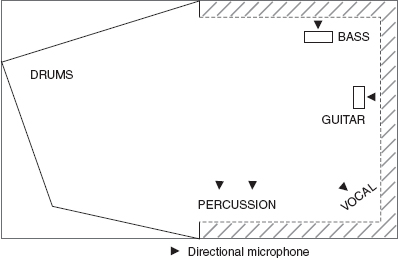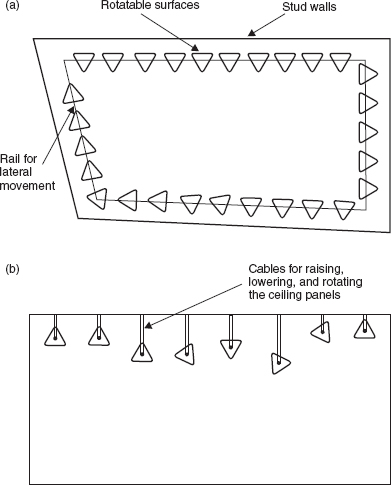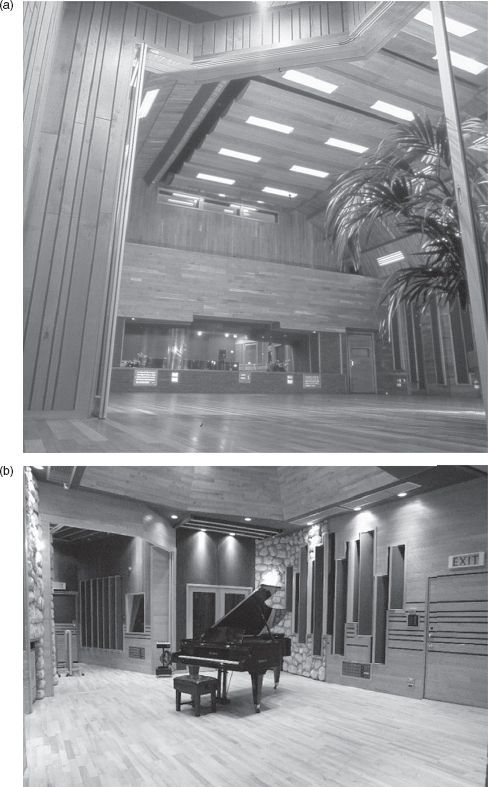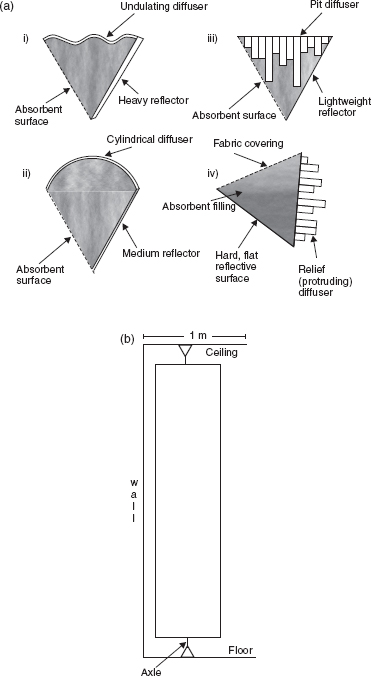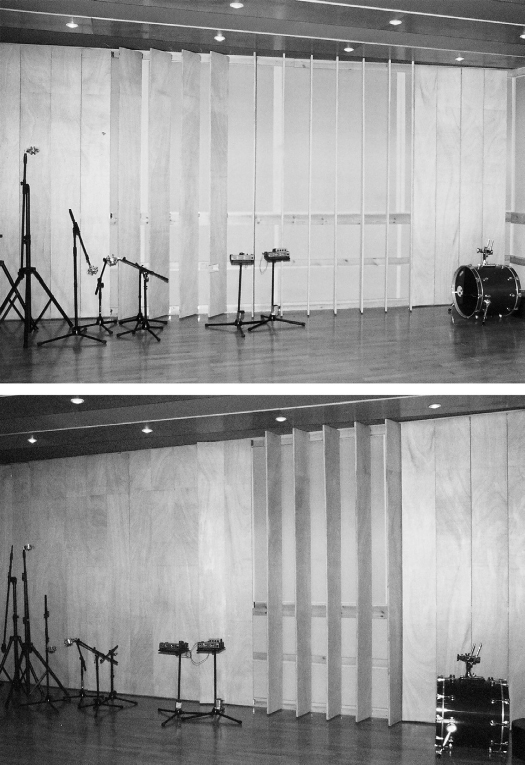CHAPTER 7
Variable Acoustics
Rooms with acoustically different zones. Rooms with directional acoustics. Changeable surfaces. Acoustic change by rotating panels. Considerations concerning different room sizes.
7.1 The Geometry of Change
A degree of acoustic variability in a recording studio is a useful asset. It allows areas of the recording spaces to be better suited to the ‘natural’ acoustics for which many instruments were made. The variability allows a studio to accommodate different types of recording, as opposed to just specialising in the recordings that suit the fixed acoustics. As discussed in Chapter 5, acoustic neutrality, although very useful in many circumstances, is not the answer when a more naturally ambient type of recording is required. Let us now, therefore, look at some ways in which acoustic variability can be brought to rooms, whether they are large, medium or small.
Figure 5.18 shows a room of fixed acoustics, although a good degree of acoustic variability can still be achieved in such a room by choosing different positions for individual instruments and microphones. On a macro scale, say by using the whole room for one instrumentalist in the centre, the room would be remarkably neutral. Subtle but significant changes in the acoustics could be obtained by rotating the musician and/or microphone(s) in order to face either the reflective, diffusive or absorbent surfaces. However, some quite marked changes in recording acoustics could be effected if the instruments were moved close to the different boundaries. The principal problem with this type of room arises when one needs to record an ensemble. This is not only because the room is not balanced about any axis, but also because the room would have a fixed and very short decay time. Nevertheless, both problems would tend to be ameliorated as the room size increased. An actual room using this type of control is shown in Figure 7.1, although the diffusers in this case are not of the cylindrical type.
Figures 7.2 to 7.4 show three possible ways of achieving acoustic variability in larger spaces. Although the type shown in Figure 7.2 is relatively cheap to construct, and highly effective, it again has the drawback of being awkward to use if a large ensemble is in the room, as a uniform acoustic could not be shared by the whole group. Figure 7.5 shows how the room could be used effectively for a typical rock group, allowing the musicians to play as one unit in close contact with each other, yet with each instrument in its own, desired, acoustic space. The results can be excellent, but unfortunately, if a larger ensemble is placed in such a room, filling more than one half of the space, either the front/back or left/right balance of direct to reverberant sound would not be uniform. It would simply not be possible to achieve a balanced, overall sound. In the area between the two halves, an interesting zone can exist where very different recordings can be achieved by the varied positioning of directional microphones. This can be done either in the vicinity of the instrument, or more distantly with ambient microphones. In the live end of the studio, walls can be made as reflective as judged to be appropriate for the work most typical for the studio.

Figure 7.1:
Dobrolyot Studio, St Petersburg, Russia (1996). Note the ex-Soviet era perforated diffusers over the glass doors and on the adjacent left-hand wall.
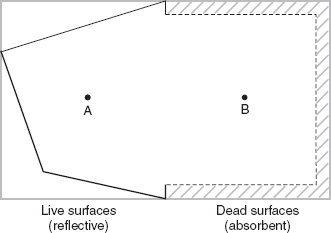
Figure 7.2:
Recording room with fixed live and dead areas.
Figure 7.3:
Recording room with graded acoustics.

Figure 7.4:
Recording room with hinged acoustic panels.
Figure 7.5:
Typical usage of room shown in Figure 7.2 with rock group. In the example above, a five-piece group could record ‘live’ using the characteristics of the room to good effect. The drums could be set up in the live area, to produce a full sound and a good feel for the drummer. Bass and guitar amplifiers face the absorbent walls, thus reducing the overspill back to the other instruments. The amplifiers also help to shield the microphones from the drums and percussion. The percussionist faces the other musicians, and the percussion microphones do not point in a direction where they are likely to collect excessive overspill, even though the percusion is in a relatively live part of the room. The vocalist, in a dead corner, faces the other musicians, but the directional vocal microphone faces the absorbent surface.
Referring again to Figure 7.2, position A would enjoy a rather live acoustic whilst position B would be much more dead. Position A is surrounded on three sides by reflective walls, whilst position B is surrounded on three sides by very absorbent walls. The only live surface directly facing position B is the far wall of the live area, which is quite some distance away. Figure 7.3 again has positions A and B, live and dead respectively, though this time the method of achieving the effect is rather different. The sawtooth arrangement of the reflector/absorber surfaces creates a situation whereby as one moves from the absorbent wall to the reflective one, there is a progressive reduction in the reflective surfaces facing the sound source. If an instrument is at position B, with a cardioid microphone at position C, facing B, then an almost dead room response would be recorded, because all the reflexions would be passing away from the front of the microphone diaphragm. Conversely, by positioning the microphone at D, many reflexions would be captured by the microphone, both from the hard wall and from at least the first three ‘sawtooth’ reflectors of each of the side walls.
The rooms shown in Figures 7.2 and 7.3 are acoustically variable in terms of both the positions of the sources of sound and the microphones, but Figure 7.4 shows a move toward a more truly variable room. In this instance, hinged panels can be moved through 90°, exposing either hard or soft surfaces to the room. By this means, either the whole room or different sections of it can be radically altered between live and dead. A variant of this theme exists where the hinged panels are in the centre of the long walls, allowing the rooms to be subdivided. They have generally been very well received, but in the case of larger rooms this type of system is somewhat impracticable. An actual example is shown in Figure 7.6.
Figure 7.7 shows a concept for a large room with quite comprehensively variable acoustics. It can probably be guessed from this that a large room with seriously variable acoustics does not come cheap. Space is consumed by the variable elements, which means that considerably more floor area is needed in the building shell than will be realised in the final recording area. Highly variable rooms tend to be both structurally complicated and expensive, but they can also be very effective recording tools when a truly multi-functional room is needed. Essentially, though, it will be seen from Figure 7.7 that almost every surface of the room needs to be capable of being changed from hard to soft if a very high degree of variability is to be achieved. In practical examples, such as shown in Figure 7.8, the ceiling panels are motorised, and their positions can be changed remotely from the control room whilst listening to the effect as it happens.
Figure 7.9 shows the details of the rotating panels that would be typically used in rooms of the type outlined in Figure 7.7 and shown in Figure 6.13. Four different designs are shown, though many other variations on this theme are possible. The diffusive sides show the options of either curved surfaces of different radii, or the quadratic residue types in both the pit and relief forms. This type of room variability technique is now widely used in concert halls. It was largely the Japanese designer, Sam Toyashima, who brought it to high profile in recording studios around the world, though the principle dates back to German broadcast studios of the 1930s. The wall panels of Figure 7.9 have three surfaces and can be rotated into any position desired. Having three surfaces gives the option of mixing any of the diffusive, reflective or absorbent characteristics by intermediate positioning. The room can be divided into live or dead areas, and, by the rotation of the panels, the reflexions are to a large degree steerable, which can create interesting effects for ambience microphones. Similar ceiling panels can be raised, lowered or rotated, and therefore can be absorbent, diffusive or reflective with varying degrees of timing for first reflexions.
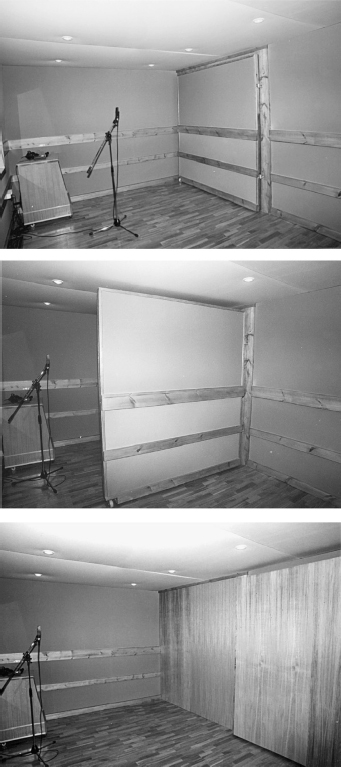
Figure7.6:
Acoustic variability by hinged panels – Sonobox studios, Madrid, Spain (2001).
Figure 7.7:
Room with high degree of acoustic variability (but at a cost of much floor area): (a) Plan; (b) Side elevation.
With rooms such as this it is often surprising to the uninitiated just how much area needs to be changed to achieve any significantly noticeable change in the general acoustics. Except for microphones and instruments in close proximity to the variable panels, rotating only three or four of them would usually be virtually unnoticeable in the context of a change in the overall acoustic of the room. It really takes a change of 15 to 20% of the overall surface area of the room to have any readily noticeable general effect. In a 15m × 10m × 5 m room, accepting for now a hard floor, it means changing something around 80 to 90 m2 of surface area for a worthwhile change in acoustics. Once over that threshold, however, the effect, in whichever direction it is acting on the room ambience, begins to develop rapidly.
Figure 7.8:
(a) The large, variable acoustics room at Olympic Studios, London, UK, designed by Sam Toyashima. The ceiling panels can be raised and lowered electrically, from the control room, enabling the acoustic changes to be monitored as they occur.
(b) Another Toyashima variable room at the Townhouse, London, UK, with semi-cylindrical, rotatable wall panels (photograph by Bob Stewart).
The rotating wall-panel technique takes up more permanent space than the method of varying the wall surfaces by movable panels, either hinged, as in Figure 7.4, or attached by some sort of hook system. However, with the hinged panel system it is more difficult to achieve the intermediate situations and it may also be less rapidly adjustable. Obviously, the hinged panels need a free space to swing out, which is perhaps not too much of a problem in a very large room, but in smaller rooms it could mean dismantling a whole drum kit just to make an experimental change. On the other hand, if the changes of acoustics can be pre-planned, the hinged/hung panel system does cause less permanent loss of space inside the isolation shell than does the rotating panel system of Figure 7.7. As usual, compromises exist in each case.
A variation on the rotating panel technique is to use multiple, small, hinged panels, as shown in Figure 7.10. The panels are made from 12 mm plywood, and about 15 mm is left between them when they are fully closed so that they can be operated individually without fouling each other. In the case illustrated, the panels are mounted over a wideband (full frequency range) absorber of about 1 m depth. The choice of 12 mm plywood was made so that the very low frequencies would still enter the absorber, as the opposing wall was stone, and there was the risk of an undesirable build up of bass frequencies if the plywood was too thick. The arrangement is very flexible, and a great number of permutations of panel combinations are available which can either deal with small zones in close proximity to the panels, or which can act on the whole room in a more general way. In the case shown in Figure 7.10, when the panels are all fully open, their effect on both the absorber and the rest of the room is negligible. This system of providing acoustic variability has proved to be useful in rooms of many different sizes. However, the absorber still needs to be quite deep if the variability is required over a wide frequency range.
Figure 7.9:
Rotating acoustic control devices: (a) Detail of rotating units – 4 variants – end views. Rotating contrivances, such as shown above, can provide reflective, diffusive or absorptive surfaces, either wholly, or in combinations by being rotated to intermediate positions. They can be applied to walls or ceilings, and can be motor driven, operated from the control room, where their effect on the recording acoustics can be judged whilst listening via the microphones. (b) Mounting arrangement for rotating acoustical devices shown in (a).
Figure 7.10:
Multiple, hinged panels covering a large, full-range absorber. These provide considerable variability to the acoustics of the room. The different combinations available are almost infinite – Rockaway Studios, Castellón de la Plana, Spain (2008).
7.2 Small Room Considerations
Small recording rooms, of less than around 50 m3, tend to be more difficult in terms of variability. They tend to flip-flop from one state to another, passing through some strange sound characters on the verge of the main changes. What is more, in a small room, the number and positions of people and equipment occupy a much greater proportion of the room volume, and hence may themselves have a great bearing on the acoustics. The variations in the surfaces of small rooms usually have to be judged once the room is ready to record, with all personnel and equipment in place. As mentioned earlier, with wheeled or hinged panels, changing things after the instruments have been positioned can become a very disruptive and slow process in a congested room. Nevertheless, once the recording staff become accustomed to how the room sounds in their typical recording situations, they can pre-set the room to a state which their experience suggests will be most appropriate for the music which they expect to be recording. A technique such as that shown in Figure 7.7 would be unlikely to be a good choice in a small room, because the overall loss of space due to the movable sections would be too great a proportion of the total space of the room.
The important point to remember is that the movable panels of Figures 7.7 and 7.9 will not scale. They cannot be built one half of the size in a room of one half of the volume. The effects of the panels are related not to room sizes but to wavelengths, and as the frequency ranges of the instruments in a small or large room remain the same, some of the dimensions of the variable wall sections must remain the same. If an absorber needs to be 1 m deep for any given frequency range, then in a room of half the total area, despite the fact that only half the surface area of absorbers may be needed, they still need to be 1 m deep. There have been many situations in which small-scale versions of these devices have been tried, but they have only been effective over much narrower frequency bands, and their sonic effect has frequently been very unnatural. For so many reasons, recording spaces tend to be like boxers; a good big one will almost always beat a good little one.
In the smaller rooms it is almost impossible to achieve situations whereby the first reflexions back to the instrument are of the late type (echoes). There are many more early reflexions returning to the musicians and the recording microphones, so the reflexions of this type produce tonal colouration rather than a sense of spaciousness. This can be off-putting for the musicians, whether they hear the sound directly or via the microphones and foldback systems, both of which can affect the way that they play. All in all, the tendency is that smaller rooms are better suited to either fixed design concepts, or to being provided with the means of gross state changes such as shown in Figure 7.6. Subtle variability rarely seems to achieve its aims in small spaces. Diffusers, also, suffer from wavelength limitations, and for good low frequency diffusion they currently need to be relatively large in their front-to-back dimension. Even the shallower amplitude gratings (see Figures 4.33 and 4.34) have a tendency to sound coloured at close distances. However, some interesting research is afoot whereby actively driven end walls at the back of the pits may be able to simulate in a shallow pit the effect of a deep one. Time will tell whether these techniques eventually deliver what they are promising. Nonetheless, in experienced hands, the idiosyncratic nature of some small, variable rooms can be put to good use, especially in the more ‘creative’ environment of modern music. In a situation where unusual sounds are being sought there can be some interesting possibilities, but one has to be careful that similar room-sound characteristics do not build up track by track to become overbearing in the final mix.
Most of the characteristic sound of the small rooms are not frequency aberrations per se, but are characteristics of the time response. It is not just the frequency content of the room sounds which stand out, but the time-performance of the resonant modes and reflexions which give rise to the idiosyncrasies of the overall decay. As such, with the problems being in the time domain, there is little hope of using the equalisation controls of the mixing console to correct the problem. Any attempts at such ‘corrective’ equalisation can seriously detract from the frequency balance of the direct sounds, and in many cases the effect of the medicine will be worse than the illness. Such room problems can usually only be solved by acoustic changes in the rooms themselves. If small rooms cannot be significantly changed acoustically, then at least the positions of subsequent recordings should be changed. If we are to use another medical analogy, although the room-related problems may not be terminal to a recording, once in the recording system they do tend to be incurable.
In smaller rooms, where the room sound is noticeable, it is of paramount importance to monitor it carefully at the recording stage, and, if any sign of a characteristic acoustic build up becomes evident, steps must be taken to ensure that further recordings on any given song are done with a varied acoustic. This may mean moving the musician(s) and/or the instrument(s); moving the microphone(s), or making use of any acoustic variability. Although changing a microphone type may change the direct/reflective pick-up characteristic, it is not likely to be as effective as the former measures because the offending time characteristics are quite likely to still find their way into the recordings. Nevertheless, idiosyncratic acoustics do have their place when they are available for effect, but to have a degree of acoustic variability as an option in the recording space is often as useful as a whole rack of effects processors in the control room.
7.3 Summary
Rooms with variable acoustics can be very useful recording tools.
Variability can be achieved in a room by constructing different zones with different characteristics, or by the use of changeable surfaces.
Hinged panels, dismountable panels and rotatable panels can all be employed to good effect.
Rooms with different acoustic zones may not be very usable when recording an ensemble, because the overall acoustic will not be spacially balanced.
Hinged panels tend to take up less space than rotating panels, but changing their position in a small room full of instruments and microphones can be very inconvenient.
Rotating, triangular-section panels can be very effective in changing the acoustics of a room, by offering reflective, diffusive or absorptive surfaces.
It is much more difficult to make subtle changes in small rooms than in large ones.
Absorber and diffuser depths are usually dependent upon the wavelength of the lowest frequencies to which they are expected to work, and they will not scale with room size.
Actively driven diffuser pits may offer the hope of shallower diffusers in the future.
Many characteristic room sounds are time domain effects, and hence cannot be adjusted by conventional electronic equalisation.


